The ecological importance of mangrove swamps is well understood. The Web site of UNESCO, which marks July 26 as the International Day for the Conservation of the Mangrove Ecosystem, describes these salt-tolerant forests as “rare, spectacular and prolific,” and points out that they “contribute to the wellbeing, food security and protection of coastal communities worldwide.”
In addition to serving as “valuable nursery habitat for fish and crustaceans,” UNESCO notes that mangrove clusters are natural defenses “against storm surges, tsunamis, rising sea levels and erosion.”
What’s more, the soils in which mangroves thrive are highly effective carbon sinks, with research suggesting that the carbon absorption rate of such ecosystems is double or triple that of terrestrial forests. The soil substrate characteristics of mangrove biomes are similar to those of rice fields, but the former emit far less methane (a potent greenhouse gas) than the latter, because salinity impedes methane-producing bacteria.
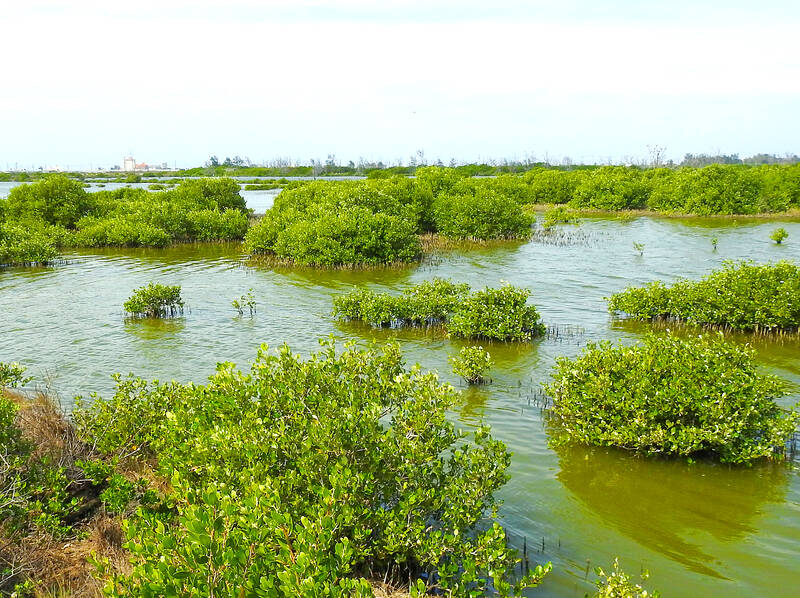
Photo: Steven Crook
According to UNESCO, the Earth is losing mangrove forests at a rate three to five times faster than that for other types of woodland. Taiwan is an exception to this trend, however — and a recent proposal might lead to a further expansion of mangrove coverage around the country.
On April 16, the Ministry of the Environment’s Climate Change Administration (CCA) published draft rules that would allow enterprises to acquire carbon credits by planting mangroves. On the same day, the CCA also issued draft regulations opening the door to seagrass restoration projects being a way to generate credits that can be traded or used to offset the sponsor’s own carbon emissions.
REFORESTING
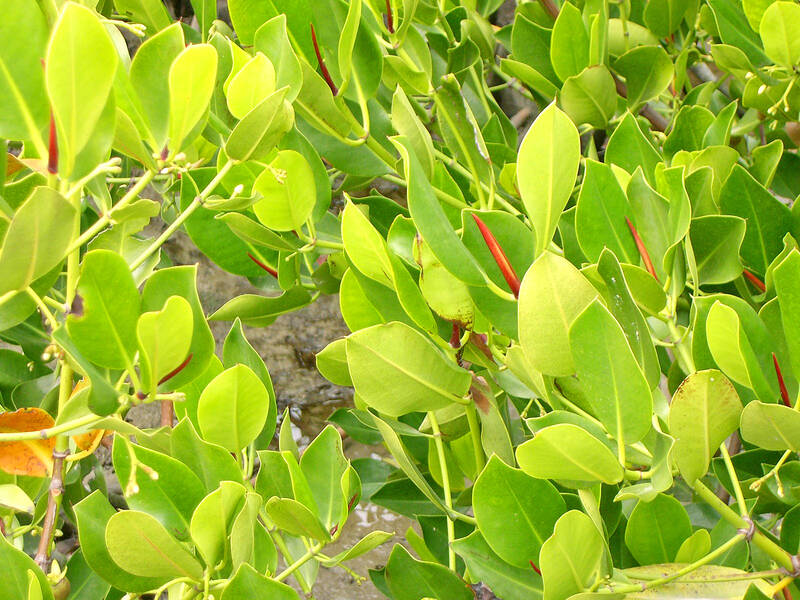
Photo: Steven Crook
Taiwan’s mangroves are doing much better now than they were a few decades ago.
Development and pollution in river estuaries and along the coast reduced the country’s mangrove forests to 178 hectares by 1976 and to as little as 120 hectares by 1985. The modernization and expansion of Kaohsiung’s harbor from the 1930s onward led to the disappearance of two of the six mangrove species then growing in Taiwan. (Around the world, there are at least 50 and perhaps as many as 80 types of mangrove.)
According to the Web site of the Ocean Affairs Council’s Ocean Conservation Administration (OCA), by 2019, mangrove coverage had rebounded to 680.7 hectares. A third of Taiwan’s mangrove forests are located in Tainan. New Taipei’s Luzhou District (蘆洲) is another place where growing environmental awareness appears to have helped mangrove ecosystems survive and expand.
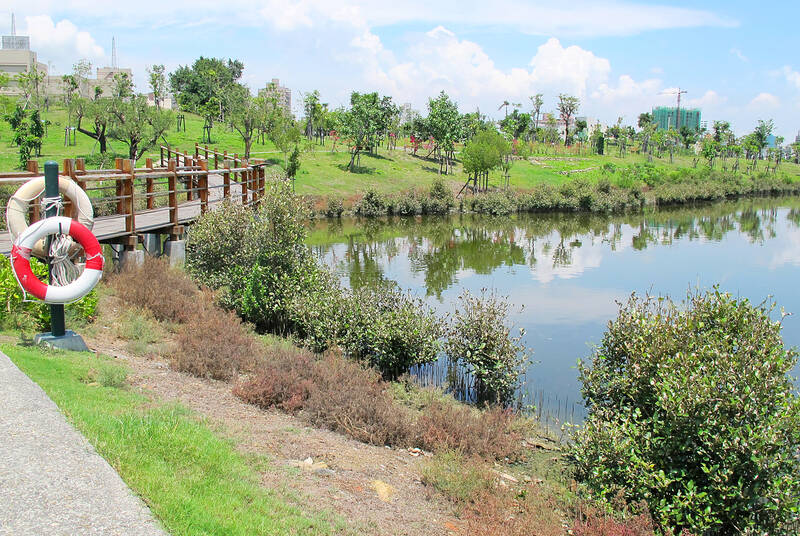
Photo: Steven Crook
Because some mangrove swamps store organic carbon up to three meters below the surface, the OCA estimates that the annual carbon absorption capacity of the country’s mangrove ecosystems is 4,486 times that of Taipei’s Daan Forest Park.
Much of the recent proliferation of mangroves is the result of human intervention. Writing in 2002, Fan Kuei-chu (范貴珠), an associate professor in the Department of Forestry, National Pingtung University of Science and Technology, noted that while several local governments launched mangrove restoration efforts in the late 1990s, “many projects failed because of unsuitable habitats and participants’ lack of basic knowledge and experience in mangrove restoration.”
However, Fan praised a 4.6-hectare project in Tainan that reintroduced Rhizophora stylosa (the red or stilted mangrove) and Lumnitzera racemosa (also known as the white-flowered black mangrove) to Anping Harbor (安平港).
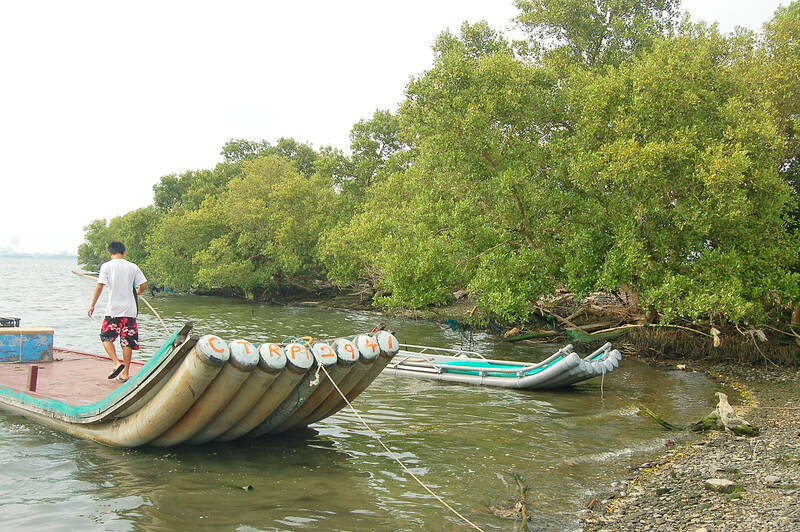
Photo: Yeh Yung-chien, Taipei Times
Since 2011, mangroves have been nurtured inside Jhongdu Wetlands Park (中都愛河濕地公園), next to the Love River in the center of Kaohsiung. The park — which was created by leveling shuttered factories and repurposing logging-industry pools — is about 4km from the river’s mouth, but near enough to the sea to be affected by rising and ebbing tides.
DRAWBACKS
In at least two places, successful mangrove-planting programs were curtailed or reversed because of negative impacts on other parts of the ecosystem (see “Whither Taiwan’s wetlands?” in the Jan. 27, 2021 issue of Taipei Times).
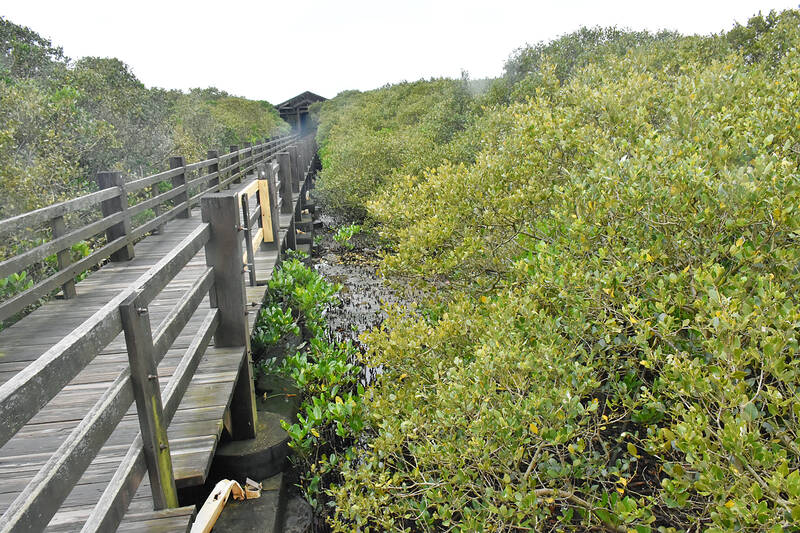
Photo: Liao Hsueh-ju, Taipei Times
Ground subsidence, caused by excessive pumping of groundwater, has harmed mangrove clusters in the counties of Changhua, Yunlin, Chiayi and Pingtung. These plants have evolved to survive being submerged in brackish water, yet they can’t stay healthy if their roots aren’t exposed to the air when the tide goes out.
Near-permanent immersion, because the land had sunk, is thought to be why many of the mangroves on the south bank of Chiayi’s Puzi River (朴子溪) died between 1986 and 1992. Parts of Taiwan’s west coast are continuing to subside. In a few places, the ground is sinking at a rate of more than 3cm per year; one reason, it seems, is the sheer weight of manmade infrastructure. On top of this, sea levels are slowly rising.
To maintain their preferred environmental conditions, such as frequency and depth of inundation, mangroves may respond to higher mean sea levels by retreating landward and colonizing new habitats. However, this is only possible where there’s an absence of seawalls and other obstacles, which certainly isn’t the case along much of Taiwan’s coastline.
A lack of sites suitable for afforestation isn’t the only reason why the CCA’s new rules might not lead to a significant proliferation of mangroves, say researchers quoted by Science Media Center Taiwan (台灣科技媒體中心).
In the May 1 online report, titled “Carbon Reduction Methodologies for Mangroves and Seagrass Beds: Expert Opinions,” Lin Hsing-juh (林幸助) — the National Chung Hsing University (NCHU) Department of Life Sciences professor who drafted the new rules — explains that, until recently, Taiwan’s carbon sink calculations didn’t consider the role of oceans and soil, but these categories can make “a significant contribution” to achieving the country’s emissions-reduction targets.
Lin argues that, if the draft methodology is approved, companies seeking carbon credits will invest in mangrove afforestation and seagrass bed restoration, bringing about “a win-win strategy of conserving biodiversity and increasing carbon sinks.”
However, he cautions that each location must be carefully evaluated, and that habitats where mangroves or seagrass previously grew should be selected. Because mangroves grow fast and may impact surrounding ecosystems, close monitoring and careful management will be essential.
Professor Shih Hsi-te (施習德), one of Lin’s colleagues at NCHU, expresses concern that new mangrove swamps could impede drainage and result in landowners suffering flood damage. What’s more, because the carbon storage capacity of mangrove biomes isn’t necessarily greater than that of other coastal wetlands, he says the authorities should integrate the opinions of ecologists, hydrologists and others, “to avoid causing further irreversible damage” to the environment.
Hsieh Cheng-i (謝正義), an associate professor in National Taiwan University’s (NTU) Department of Bioenvironmental Systems Engineering, points out that the carbon sink capacity of Taiwan’s existing mangrove and seagrass ecosystems is approximately 86,000 metric tons per year, a mere “drop in the bucket” compared to the country’s annual greenhouse gas emissions of around 297 million metric tons of carbon dioxide equivalent.
Nonetheless, any effort to reduce global warming deserves our attention, he says, adding that, while mangrove afforestation and seagrass bed restoration can only offset a tiny proportion of Taiwan’s carbon emissions, such actions may also protect certain habitats and prevent coastal erosion.
Ensuring that mangrove or seagrass projects don’t become examples of “greenwashing” will require accurate scientific measurement, says Shiau Yo-jin (蕭友晉), an assistant professor in NTU’s Department of Bioenvironmental Systems Engineering. Such efforts might have another benefit, he adds: They’re likely to help the public understand the importance of conservation and sustainability, and help protect the environment.
Skeptics have asked if allowing private enterprises to sponsor mangrove afforestation and seagrass bed restoration might lead to de facto private ownership of state-owned land along the coast. Others are wondering if clearing the way for such initiatives might make it easier for polluters to evade their overarching responsibility to reduce emissions. That, of course, must be a consideration when devising or proposing any type of offset or carbon-trading scheme.
Steven Crook, the author or co-author of four books about Taiwan, has been following environmental issues since he arrived in the country in 1991. He drives a hybrid and carries his own chopsticks. The views expressed here are his own.

Cheng Ching-hsiang (鄭青祥) turned a small triangle of concrete jammed between two old shops into a cool little bar called 9dimension. In front of the shop, a steampunk-like structure was welded by himself to serve as a booth where he prepares cocktails. “Yancheng used to be just old people,” he says, “but now young people are coming and creating the New Yancheng.” Around the corner, Yu Hsiu-jao (饒毓琇), opened Tiny Cafe. True to its name, it is the size of a cupboard and serves cold-brewed coffee. “Small shops are so special and have personality,” she says, “people come to Yancheng to find such treasures.” She

In July of 1995, a group of local DJs began posting an event flyer around Taipei. It was cheaply photocopied and nearly all in English, with a hand-drawn map on the back and, on the front, a big red hand print alongside one prominent line of text, “Finally… THE PARTY.” The map led to a remote floodplain in Taipei County (now New Taipei City) just across the Tamsui River from Taipei. The organizers got permission from no one. They just drove up in a blue Taiwanese pickup truck, set up a generator, two speakers, two turntables and a mixer. They

Former Chinese Nationalist Party (KMT) chairwoman Hung Hsiu-chu’s (洪秀柱) attendance at the Chinese Communist Party’s (CPP) “Chinese People’s War of Resistance Against Japanese Aggression and the World Anti-Fascist War” parade in Beijing is infuriating, embarrassing and insulting to nearly everyone in Taiwan, and Taiwan’s friends and allies. She is also ripping off bandages and pouring salt into old wounds. In the process she managed to tie both the KMT and the Democratic Progressive Party (DPP) into uncomfortable knots. The KMT continues to honor their heroic fighters, who defended China against the invading Japanese Empire, which inflicted unimaginable horrors on the

Hannah Liao (廖宸萱) recalls the harassment she experienced on dating apps, an experience that left her frightened and disgusted. “I’ve tried some voice-based dating apps,” the 30-year-old says. “Right away, some guys would say things like, ‘Wanna talk dirty?’ or ‘Wanna suck my d**k?’” she says. Liao’s story is not unique. Ministry of Health and Welfare statistics show a more than 50 percent rise in sexual assault cases related to online encounters over the past five years. In 2023 alone, women comprised 7,698 of the 9,413 reported victims. Faced with a dating landscape that can feel more predatory than promising, many in